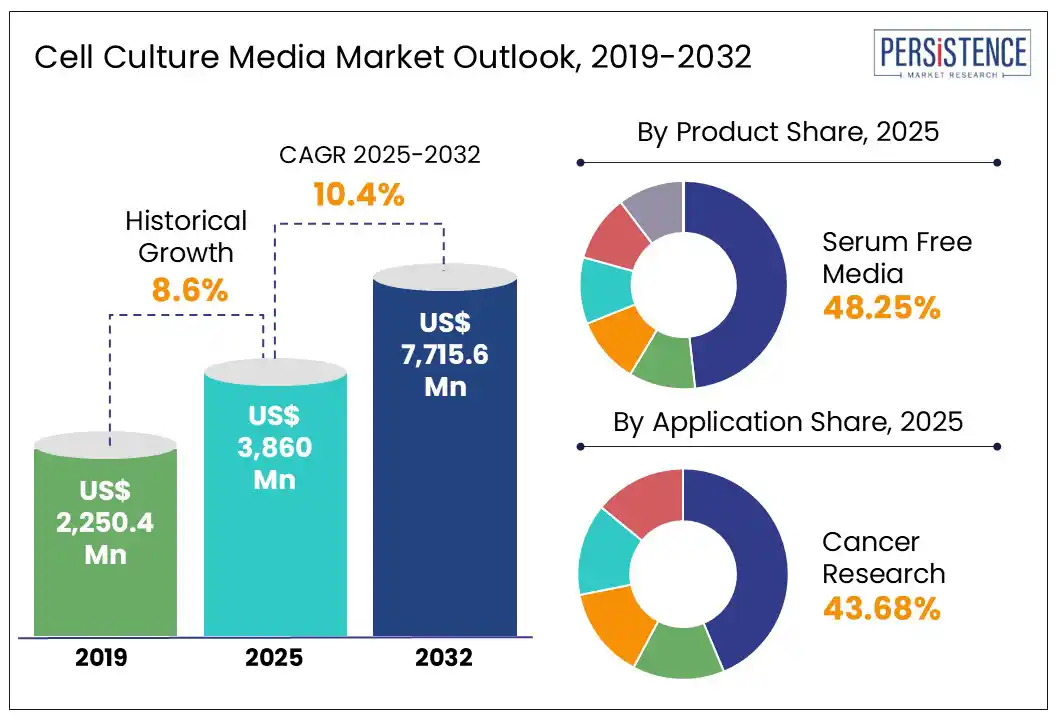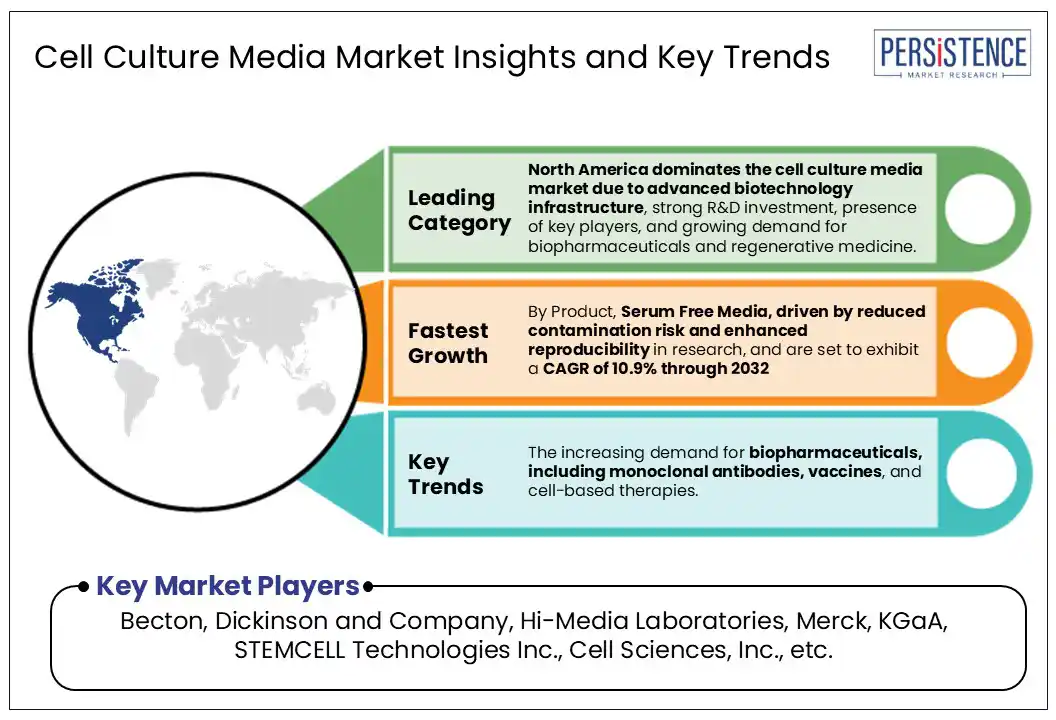ID: PMRREP31338| 195 Pages | 25 Jun 2025 | Format: PDF, Excel, PPT* | Healthcare

The global cell culture media market size is valued at US$ 3,860.0 million in 2025 and is expected to reach US$ 7,715.6 million by 2032 to reach a CAGR of 10.4% from 2025 to 2032.
Cell culture is a process for harvesting cells in an in vitro setting. Typically, cells need nutrient-rich medium and a sterile environment to thrive properly. The media used in cell culture is often semi-solid, liquid, or gel-based and is created to facilitate cell growth. Amino acids, glucose, inorganic salts, and serum that promote cell development often make up cell culture media.
The market growth is projected to grow during the forecast period due to the rising disease treatments using artificial organs and tissue grafts, and research funding. Also, the cell culture media market is expanding due to the benefits of culture media in tissue or organ recovery.

Key Industry Highlights:
|
Global Market Attribute |
Key Insights |
|
Cell Culture Media Market Size (2025E) |
US$ 3,860.0 Mn |
|
Market Value Forecast (2032F) |
US$ 7,715.6 Mn |
|
Projected Growth (CAGR 2025 to 2032) |
10.4% |
|
Historical Market Growth (CAGR 2019 to 2024) |
8.6% |
The rising demand for targeted cancer therapies significantly drives the market. Targeted therapies, which address specific molecular and genetic abnormalities in cancer cells, require highly controlled and optimized cell culture conditions. Cell culture media are essential in maintaining the viability and functionality of cancer cell lines during research and drug screening processes.
Researchers rely on specialized media to cultivate various cancer cell types, enabling the evaluation of drug efficacy and toxicity in vitro. Moreover, cell culture media are pivotal in cancer stem cell research, facilitating the isolation and characterization of these cells. This allows scientists to explore tumor initiation, resistance mechanisms, and the development of therapies aimed at eliminating cancer stem cells. As targeted oncology advances, the need for precise and high-quality culture media continues to grow, fueling market expansion.
Contamination risks stand as a formidable restraint in the market, significantly impacting the reliability and reproducibility of experiments and processes. Maintaining a sterile and contamination-free environment is paramount in cell culture, yet challenges persist in preventing the introduction of unwanted microorganisms such as bacteria, fungi, and viruses. Contaminated cell cultures not only jeopardize the integrity of research outcomes but pose potential threats to the health and safety of cell-based therapies in the biopharmaceutical industry. Researchers and manufacturers face the continuous challenge of implementing stringent aseptic techniques, maintaining clean laboratory conditions, and navigating the complexities of large-scale production.
The increasing incidence of infectious diseases presents a significant opportunity for the market. With the global rise in bacterial, viral, and parasitic infections, there is a growing need for effective diagnostics, vaccine development, and therapeutic research all of which rely heavily on cell culture systems. Cell culture media provides the essential environment for the growth of pathogens, host cells, and immune cells, enabling researchers to study disease mechanisms and develop targeted interventions.
Furthermore, the COVID-19 pandemic underscored the urgent need for rapid vaccine production and testing, highlighting the importance of high-quality, scalable cell culture media. Parallel to this, cancer continues to be a major global health burden with over 20 million new cancer cases reported worldwide in 2022 (WHO). The dual challenge of infectious diseases and cancer underscores the demand for advanced cell culture media to support research, development, and large-scale manufacturing of life-saving therapies.
The serum-free media segment dominated the market in 2024. One of the primary factors contributing to this dominance is the increasing R&D expenditure focused on cell-based diagnostics. Numerous medical institutions and biopharmaceutical companies collaborate on research areas such as molecular genetics, cell biology, cancer research, and plant biology, utilizing serum-free media to enable more efficient assessment and monitoring. Serum-free media offer advantages such as reduced contamination risk and enhanced reproducibility, making them preferred for sensitive applications. Meanwhile, the chemically defined media segment is the fast-growing segment. Its growth is driven by the demand for more consistent, animal-origin-free formulations that improve cell culture performance and meet regulatory requirements, especially in biopharmaceutical manufacturing and advanced therapeutic development. This trend highlights the industry’s shift toward safer and more reliable media solutions.
In 2024, cancer research dominated the global cell culture media market by application. The increasing number of cancer cases drives continuous efforts by researchers to develop innovative treatments, alongside rapid advancements in cancer therapies and drugs. A significant trend is the development of advanced in vitro animal models for chemotherapeutic research, where cell cultures play a crucial role. These models are often used before animal testing, providing a foundation for creating new cancer diagnostics and treatments.
Additionally, the biopharmaceutical production segment within the market for cell culture media is expected to experience the highest growth during the forecast period. This expansion is fueled by substantial investments in research and development and the ongoing growth of pharmaceutical and biotechnology companies worldwide, which are intensifying their focus on biologics and personalized medicine.

?North America led the global cell culture media market in 2024, driven primarily by the expansion of the pharmaceutical and biotechnology sectors. The region's significant market share is supported by increasing approvals of cell culture-based vaccines and a rising prevalence of diseases like cancer, which fuel demand for advanced cell culture solutions.
Additionally, substantial investments and funding in cell-based research further boost market growth. Within North America, the U.S. cell culture media market accounted for the largest share in 2024. This dominance is attributed to strong government support and increased R&D investments by major pharmaceutical and biotechnology companies. The U.S. continues to focus on innovation in biologics and personalized medicine, contributing to the ongoing growth and adoption of advanced cell culture media technologies across research and commercial applications.
?The market is driven forward by factors such as growth in the European biopharmaceutical industry, an increase in government initiatives to support research to find a cure for the rising number of chronic diseases, an increase in pharmaceutical manufacturers, improving economies, high disposable income per person, and increased healthcare spending.
In the UK, cell culture media is expected to witness substantial growth during the forecast period. Increased investment in innovative cell culture technologies and the emergence of domestic players introducing advanced solutions are key growth drivers. Germany cell culture media market also plays a crucial role in the European market, being the region’s largest biopharmaceutical producer.?
The Asia Pacific cell culture media market is projected to witness the fastest growth due to rising awareness of cell culture applications and increasing investments in biomedical research. In 2024, China held a significant share, driven by advancements in gene therapy and strong government support for biotechnology development. The Chinese government’s "Healthy China 2030" initiative and a growing focus on regenerative medicine are further accelerating market growth.
India is rapidly emerging as a key player in the market, driven by the expansion of pharmaceutical manufacturing, biotechnology startups, and clinical research organizations. This growth is supported by increasing investments in drug discovery, vaccine development, and biosimilar production, creating a strong demand for high-quality cell culture media. In Japan, the market is witnessing growth due to a high prevalence of chronic diseases, an aging population, and a robust focus on R&D in regenerative medicine. Government initiatives and collaborations between academia and industry are boosting innovation in cell-based therapies, further driving the need for advanced and reliable cell culture media solutions.
Leading manufacturers are incorporating effective and efficient media cultures to bolster their product ranges globally. Several significant competitors in the cell culture media sector have carried out similar consolidation actions, such as mergers and acquisitions. The expansion of company partnerships to improve their cell culture media in chemotherapeutic research is another important strategy observed in the sector.
The global market is estimated to increase from US$ 3,860.0 million in 2025 to US$ 7,715.6 million in 2032.
The global market is driven by rising biopharmaceutical production, increased stem cell and regenerative medicine research, and growing demand for monoclonal antibodies and personalized medicine.
The market is projected to record a CAGR of 10.4% during the forecast period from 2025 to 2032.
Becton, Dickinson and Company, Hi-Media Laboratories, Merck, KGaA, STEMCELL Technologies Inc., Cell Sciences, Inc., and Others.
Key opportunities include expanding applications in gene therapy, increasing investments in cell-based research, rising demand in emerging markets, and technological advancements in serum-free and chemically defined media.
|
Report Attribute |
Details |
|
Historical Data/Actuals |
2019 - 2024 |
|
Forecast Period |
2025 - 2032 |
|
Market Analysis Units |
Value: US$ Mn, Volume: As applicable |
|
Geographical Coverage |
|
|
Segmental Coverage |
|
|
Competitive Analysis |
|
|
Report Highlights |
|
|
Customization and Pricing |
Available upon request |
By Product
By Form
By Application
By Distribution Channel
By Region
Delivery Timelines
For more information on this report and its delivery timelines please get in touch with our sales team.
About Author